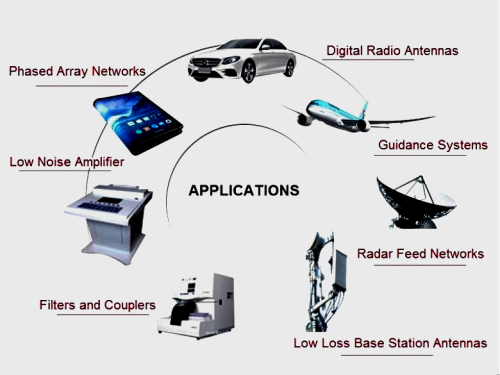| |
 |
| |
|
|
|
|
|
| |
|
What is Dielectric Constant in High Frequency PCB? |
|
|
|
| |
|
What is dielectric constant in high frequency PCB? In modern electronic devices, high-frequency PCB design has become a key technology. As one of the core performance indicators of PCB, the dielectric constant(DK) plays an indispensable role in the design and manufacturing process. |
|
|
|
| |
|
|
|
|
| |
|
1.Basic Definition of Dielectric Constant |
|
|
| |
|
The dielectric constant( includes process dielectric constant and design dielectric constant) is a measure of a material's ability to store electrical energy in an electric field. Process dielectric constant (PDC) refers to the dielectric constant measured during the manufacturing process, taking into account factors such as temperature, humidity, and material composition. And design dielectric constant (DDC) indicates the dielectric constant used in the design phase, based on ideal conditions and typically provided as a standard value by the material manufacturer. |
|
|
| |
|
|
|
|
| |
|
2.Function of Dielectric Constant |
|
|
| |
|
"Choosing the right dielectric constant is like building a highway for your circuit." In high-frequency applications, a lower dielectric constant facilitates faster signal propagation on PCBs while enhancing signal quality, which is vital for high-speed, broadband circuits. For instance, in radio frequency (RF) and microwave applications, low dielectric constant materials like PTFE minimize signal loss and increase bandwidth, allowing reliable transmission of signals at higher frequencies. Changes in the dielectric constant can significantly impact the PCB's characteristic impedance and signal delay, making material selection essential for optimal performance. |
|
|
| |
|
|
|
|
| |
|
3.Best Practices for Selecting Dielectric Constant |
|
|
| |
|
|
|
|
| |
|
3.1 Material Selection:
When choosing PCB materials, priority should be given to their dielectric constant. Common high-frequency materials manufacturer include Rogers,Taconic and Wangling , among others, which have varying dielectric constants suitable for different applications. |
|
|
| |
|
|
|
|
| |
|
3-1. Common High - Frequency PCB Materials
Material |
Design Dielectric Constant (εr) |
Major Application Area |
Taconic |
2.17 - 10.20 |
communication base stations, high-end electronic equipment |
Rogers |
2.17 - 12.20 |
automotive electronics ,
Industrial high power applications |
Wangling |
2.17 - 25.00 |
microwave and millimeter wave |
|
|
|
| |
|
|
|
|
| |
|
Among them, Rogers DiClad 880 laminates are suitable for PCB substrates in various low-loss applications. Rogers DiClad 880 laminates are woven fiberglass - reinforced, PTFE - based composites designed for use as PCB substrates with a lower dielectric constant (PDC of 2.17/2.20, DDC of 2.20) and a lower dissipation factor of 0.0009 at 10GHz. The benefits of Rogers DiClad 880 laminates include being the lowest moisture absorption among PTFE based composites, having a stable Dk over a wide frequency range, and the low Dk supporting wider line widths for lower insertion loss. |
|
|
| |
|
|
|
|
| |
|
3-2. PCB Capability (DiClad 880)
PCB Capability (DiClad 880) |
PCB Material: |
Woven Fiberglass Reinforced, PTFE-based Composites |
Designation: |
DiClad 880 |
Dielectric constant: |
2.20 (10 GHz) |
Dissipation factor: |
0.0009 (10 GHz) |
Layer count: |
Double Sided PCB, Multilayer PCB, Hybrid PCB |
Copper weight: |
1oz (35µm), 2oz (70µm) |
Dielectric thickness: |
20mil (0.508mm), 30mil (0.762mm), 60mil (1.524mm) |
PCB size: |
≤400mm X 500mm |
Solder mask: |
Green, Black, Blue, Yellow, Red etc. |
Surface finish: |
Bare copper, HASL, ENIG, Immersion silver, Immersion tin, OSP, Pure gold plated etc. |
|
|
|
| |
|
|
|
|
| |
|
3-3. The applications of Rogers DiClad 880 laminates |
|
|
| |
|

|
|
|
| |
|
|
|
|
| |
|
3.2 Simulation and Testing:
During the design phase, electromagnetic simulation software can be used to model the impact of different dielectric constants on circuit performance. This approach helps designers optimize PCB designs and mitigate potential issues. |
|
|
| |
|
|
|
|
| |
|
3.3 Influence of Temperature and Humidity:
The dielectric constant is affected not only by the material itself but also by environmental factors. Variations in temperature and humidity can lead to fluctuations in the dielectric constant, so designers need to consider these factors in real-world applications. |
|
|
| |
|
|
|
|
| |
|
4.Conclusion |
|
|
| |
|
In high-frequency PCB design, the dielectric constant determines whether your signals can be transmitted smoothly. As the saying goes, "Success in design comes from attention to detail." Reasonably selecting appropriate dielectric constant materials helps to design efficient and stable high-frequency circuits, making electronic products stand out in the highly competitive market. |
|
|
| |
|
|
|
|
|
| |
|
|
|
|
|
| |
|
|
|
|
|
| |
|
|
|
| |
|
|
|
| |
|
|
|
|
|